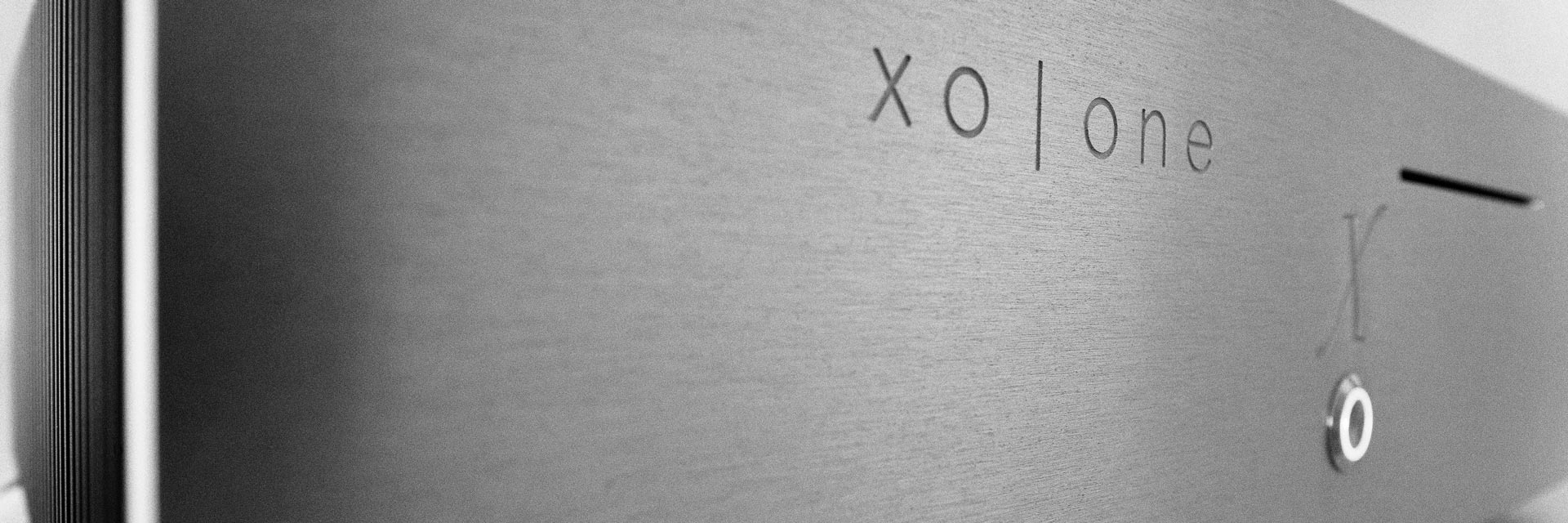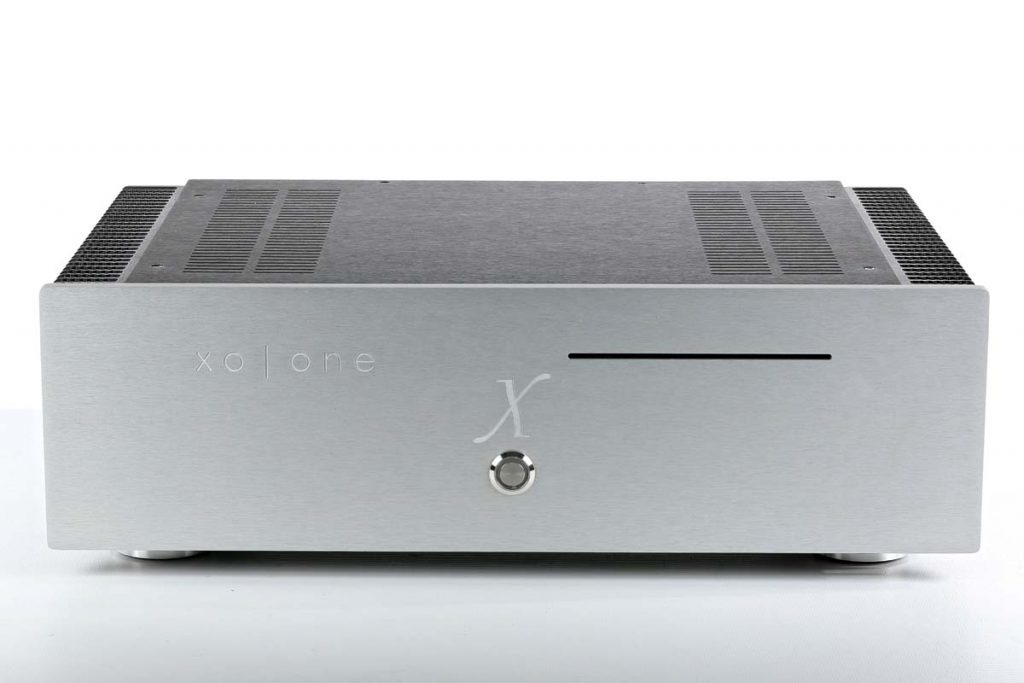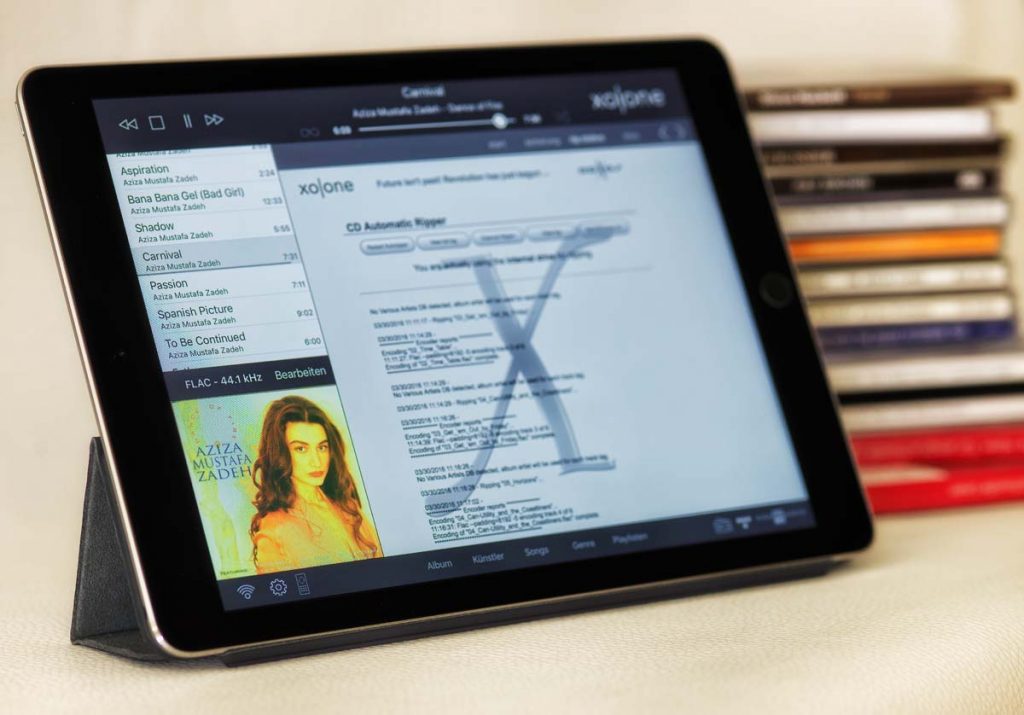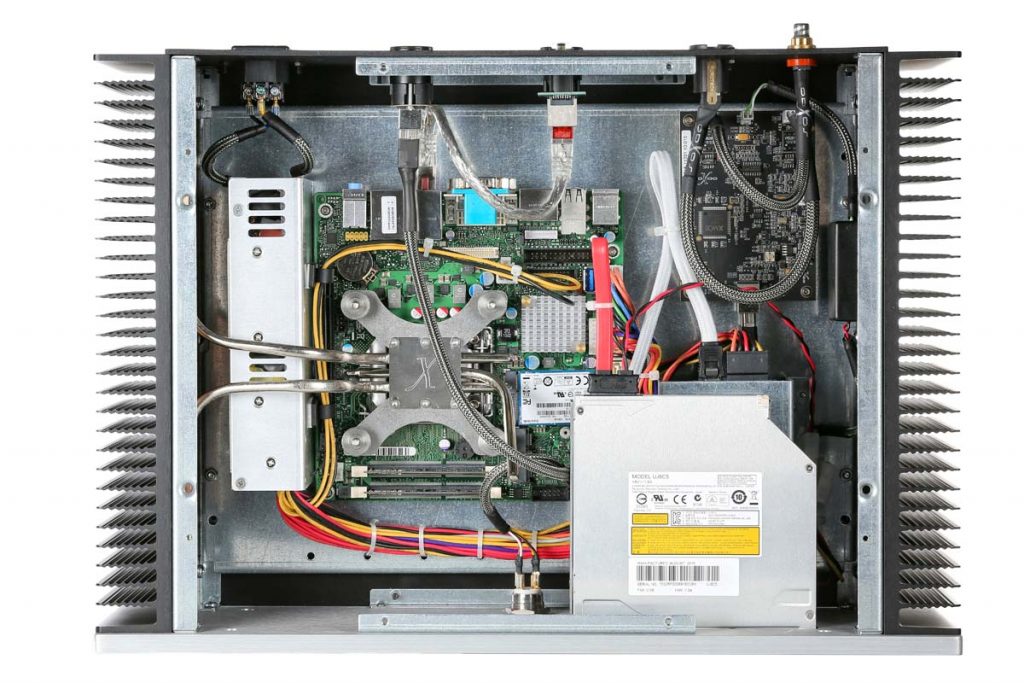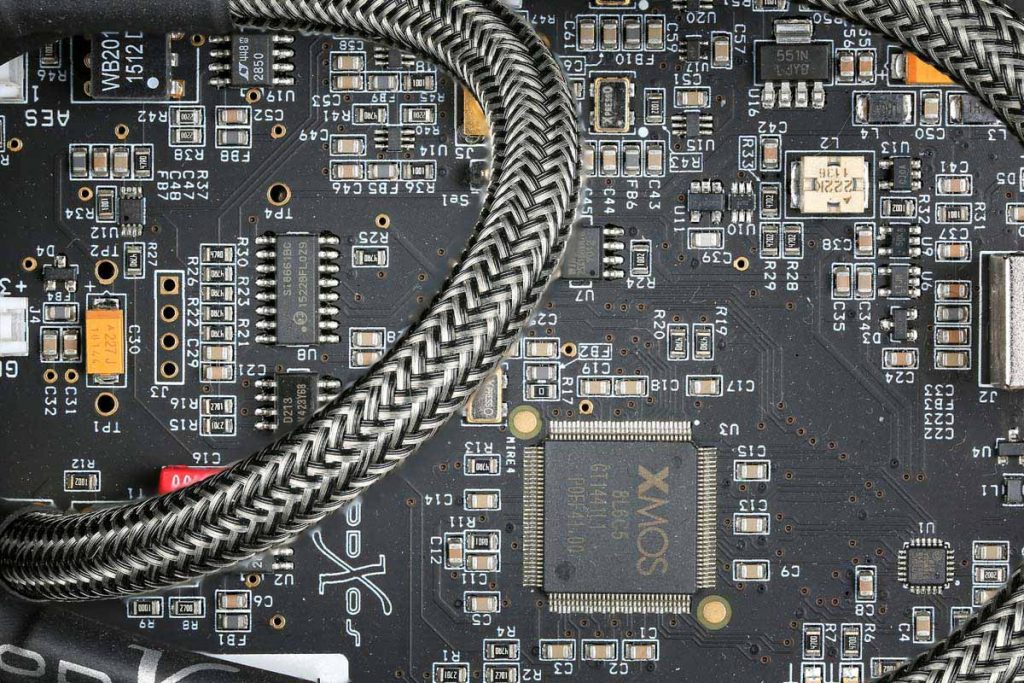Charismatic High-Tech Heavyweight
A newcomer to the scene, the x-odos xo|one wants to attract the attention of digital audiophiles—and has a long list of great arguments working in its favor.
Christof Poschadel is the mastermind behind x-odos, a relatively new company based in the German city of Freiburg. His primary goal is to create devices for digital audiophiles that reflect cutting-edge standards. This is why the xo|one music server, the company’s very first product, is designed so it can be controlled using an iPad or iPhone. No conventional remote-control devices or control panels are provided. As the x-odos manager explains: “We did initially consider having a touchscreen, but this was quickly dismissed as being too outdated. So the xo|one can be exclusively controlled over a network and by using our app.” Although this app currently only runs on Apple devices, an Android version is being developed. The xo|one was unveiled at HIGH END in 2015, but the version of we were able to test contained a number of modifications to the unit originally showcased at the fair. First and foremost, the xo|one is a music server is capable of storing music files on an internal storage device (that has at least one terabyte of memory). The basic configuration with a one terabyte solid-state disk costs €6,000, and you have a choice of silver-, black- or champagne-colored faceplates. According to Christof Poschadel, the champagne color is intended for “Accuphase fans.” Although the device can handle music files from a network or external storage devices, the files need to be stored on the internal hard disk before they can be played. The built-in drive looks like a normal CD player, but it can be used exclusively for ripping music CDs. The xo|one has no digital-analog converter of its own, so you’ll need such a device before converting ones and zeros back into sound waves. Digital data can be output either in S/PDIF or—and this is a very recent addition—in the studio-quality AES/EBU format. But development work at x-odos continues in this area, too. As Christof Poschadel explains: “We’ll soon be able to provide a D/A converter as well—developed and manufactured in-house, of course. It’ll be integrated into our upcoming streamer and also be available as a stand-alone device that can be added to our xo|one.”
High-tech for hi-res
Let’s move on to the test bundle we received, comprising xo|one, iPad and additional accessories, some of which were also brand new. After opening our package, we first took a good look at the music server itself—the star of the show. Weighing in at 14 kilos, the xo|one is a hefty yet elegant unit. Primarily responsible for this weight are the heavy heat sink fins located on the left and right of the device and the faceplate made of solid brushed aluminum. Although a music server is really a specialized type of computer, x-odos decided against installing an active cooling system. Not wanting to spoil the musical enjoyment with noise from a fan, they decided to use passive cooling instead. The music files are stored on an internal solid-state drive (SSD), with our test server offering one terabyte of space. Unlike conventional hard disks, solid-state drives have no moving parts. This and the use of passive cooling means the server operates almost completely silently. The SSD is used only for storing music files—the xo|one’s operating system is located on a conventional hard disk.
Taking a critical look at the interior of the device, it becomes immediately clear that the server has been carefully assembled using high-quality components. The manufacturer has opted to install expensive, industry-grade mainboards, bringing longterm robustness and simplifying any necessary maintenance. The CD drive is on the right-hand side of the housing and can be used solely for bit-perfect ripping of CDs. The first xo|one models had TEAC drives, but our test device was equipped with one from Panasonic. “Both are equally good,” explains Poschadel. “Of these two drives, we install whichever is more readily available at the time of manufacture. Each xo|one is built by hand, and every component is rigorously tested. We use only premium parts.” CDs are ripped automatically. All you need to do is insert the CD into the slot. After the disc has been pulled in, the xo|one starts the ripping process, accompanied by a low humming sound. An album with 45 minutes of music takes around seven minutes to fully rip. The individual tracks are converted into the free lossless audio codec (FLAC) format. These files require only a modest amount of disk space. According to the manufacturer, the one terabyte SSD can store . up to 3,000 CDs. In the highest configuration level (with a four terabytes SSD, costing around €8,000), the xo|one has room for some 12,000 albums.
A database for everyone
Neither network integration nor the operating app is necessary to rip CDs. This heavyweight from Freiburg really has, however, been designed as a server for precise, bit-perfect and jitter-free digital music signals. Digital audiophiles use devices like this one to store and play what is known as hi-res music—that is, high-resolution digital audio files. According to the accepted definition, this includes any material that has a resolution higher than the usual CD quality (16 bit/44.1 kHz). The xo|one can deal with all the common compressed and uncompressed formats, including DSD, up to a maximum of 24 bits (bit depth) and 192 kHz (sample rate). To store files such as these on the xo|one’s solid-state drive (and listen to them afterward) the device must be integrated into the network. The operating app is also required for this. Set-up is generally pretty easy. The music server must be connected to a vacant LAN port using the high-quality cable provided. Once it has been switched on, it should pop up on your computer (in Mac OS X-Finder or Windows Explorer) as a “PC server” under its own name. If this doesn’t happen, restart the router (if necessary), set up a Wi-Fi connection to the iPad and then start the xo|one app. Touch the radio symbol at the lower left of the screen to open the Connections window. That’s it!
You should now see the xo|one and can get started. The CD we ripped beforehand is already in the library. But because it was ripped while we were working offline, it is shown as an “unknown album.” As this is not what we would want, we deleted the folder (working from the PC) and then inserted the CD again. After touching the xo|one logo at the top right of the app and “rip status” in the next menu, we can monitor the ripping process. The app consults the FreeDB and MusicBrainz databases, retrieving the CD’s metadata and cover (if available). The hit rate was pretty good in the CDs we used: the app made a mistake with only one of our 10 test albums. And we assume that more powerful databases such as Gracenote or AMG will deliver even better results. Connections to these databases are planned, assuming x-odos and the providers can reach an agreement on licensing fees. Such fees can be really “horrendous,” says Poschadel, especially for a small, relatively new company such as x-odos. The app already has a built-in connection to the online shop of one of the leading providers of studio-quality HD downloads—HighResAudio. xo|one owners who have set up an online account with this provider can purchase and download high-resolution material directly from the app. It’s a simple and convenient process. You can listen to Internet radio from the app as well.
Especially those music fans who’ve had more than enough of mainstream offerings will find a whole new world of less widely played genres to rekindle their interest. Because the xo|one also supports UPnP, its music library is available to other devices on the network, and it can be used as a NAS server. We tested this by playing Sinatra’s Come and Fly with Me album using a MacBook Pro and Audirvana Plus. It worked perfectly. The music library can be edited at any time from a networked computer using a standard Web browser. All you need is the xo|one’s IP address (available from the app). The connection is easy to use, even for those with limited knowledge of computers and networking. You can also use this method to import and export data over the USB 3.0 interface. Making backups of your data on an external storage device is particularly easy. As an alternative, you can use the Mac OS X-Finder or Windows Explorer on your computer to copy files to connected disks or USB sticks. You can, of course, also copy data into the server’s music library from other devices.
Turning data into sound
x-odos tries to make it as easy as possible for xo|one buyers to enjoy their music, and their app is exceptionally user friendly. The company has developed a LAN infrared transmitter as an optional add-on (€200). Soon to go into series production, this device is able to remotely adjust the hi-fi system’s amplifier over the app. Poschadel provided setup assistance over the phone when we tested the preproduction model of this device. The series model will require no such assistance. Adjusting the volume from the app through the infrared interface is certainly convenient, but you can definitely enjoy the xo|one without it as well.
Once you have listened to a ripped CD from the xo|one and then play the album on a semi-professional CD player (both devices connected first to a Violectric DAC V800 and then a Mytek Digital Stereo192-DSD DAC), you will clearly hear the enormous difference in quality. I have never experienced the “Dance of Fire” ethno jazz album by Aziza Mustafa Zadeh and her all-star backing group in such precise depth and breadth and with such finely controlled dynamism. The same can be said for the excellent Brazilian guitar duo of Martin Müller and Oscar Ferreira or the classical guitar version of “Tubular Bells” played by Duo Sonare. It quickly became evident that a CD is no match for bit-perfect and practically jitter-free digital data from a music server of this quality. Interestingly enough, the music appears to be even more expansive and three-dimensional heard over the AES/EBU port than through the S/PDIF interface. It would seem this new digital port is a true bonus for listeners.
Once high-resolution music is involved, the fun really starts for audiophiles. The 24 bit/88 kHz version of the “A Capella I” album from the legendary vocal group The Singers Unlimited is packed with so much volume and subtlety that I ended up playing it three times over. And once I’d heard Oscar Peterson tickling his Steinway’s ivories with such finesse on the DSD version of his MPS solo album “My Favorite Instrument,” the verdict was crystal clear: The xo|one is a high-tech device that’s enormous fun to own, and, most importantly, is honey to the ears of discerning audiophiles.
Music server
x-odos xo|one
Functional principle: music server with automatic CD ripping and NAS function | Connections: 2 x digital out (AES/EBU, S/PDIF), USB 3.0 (file import/ export via intranet), LAN | Music data storage: SSD, 1 to 4 TB (upgradeable) | Compatible formats: all formats up to 24 bit/192 KHz | Special features: own control app for iOS devices (Android version to follow) with integrated HiRes download shop and Internet radio, passive cooling, optional network infrared interface (200 euros) | Casing: front in silver, black or “champagne” | Dimensions (W/H/D): 45/14.5/33 cm | Weight: 14 kg | Warranty period: 2 years (including online support) | Prices: starting from 6,000 euros
Xodos GmbH
Schwaighofstraße 2
79100 Freiburg
Phone +49 (0)761 88141258

